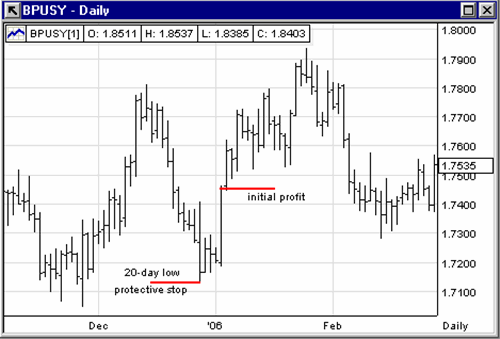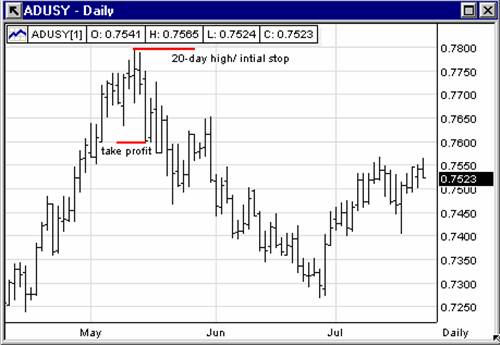Breakout After Failure
In
Street Smarts, Larry Connors and Linda Raschke
outline a trading pattern which they named Turtle Soup Plus One, a variation of
their Turtle Soup pattern. Although the authors intended the pattern to be
used on stocks, futures and commodities, the principles can be easily
transferred to the Forex market. Let’s look at the rules for Turtle Soup
Plus One and find some Forex trades that highlight this powerful pattern.
Turtle Soup can be traded in any time-frame, so let’s take a look at a Forex
swing trade.
Rules:
- The currency makes a new 20-day low. The previous
20-bar low must have been made at least three trading sessions earlier.
The close of the new low (day one) must be at or below the previous 20-bar low. - 2. An entry buy stop is placed the next day (day two) at the earlier 20-day low.
If you are not filled on day two, the trade is cancelled. - 3. If filled, place a protective sell stop one tick under the lower of the
day-one low or the day-two low. - 4. Take partial profits within two to six bars and trail a stop on the balance
of your position.
In the first chart, we see that the British Pound was
declining against the U.S. Dollar rapidly through the end of December. On
12/28 we see that the Pound made a new 20-day low, and the close was below the
previous 20-day low’s close, which happened to be a rally day. So, we put
a buy order in for the next morning, with a stop one tick below the new 20-day
low. The rules call for taking profits within two to six days, and on the
fourth day of the trade, we see a massive bounce as the currency snaps back from
the lows. Exit strategies can be tuned individually, but an easy one to
remember is to take out 1/2 of your position, to ensure you have some profits
locked in. Let the second half ride with a trailing stop, and leave this
one for the books.

The rules are exactly the same for short sells, except that
they are reversed. Instead of buying 20-day lows, you are selling 20-day
highs. The Australian Dollar rallied through April into May before
reaching a 20-day high on 5/11. The following morning we would place a
sell order, with a stop one tick above the 20-day high. The currency
tested resistance, but eventually gave up and closed down for the day. The
following day, we see a large move down as price snaps back from the new highs.
Here we would take some profit, letting those who can stomach wild swings hold
on for the ride over the next few days. The currency declined for the rest
of the month, and continued to for most of the next month as well.

So when a currency
makes a new 20-day high/low, be alert for some type of correction. New highs become
old highs and new lows become old lows. After reaching an extremity, price
will often pullback, so be ready to capitalize
on those moves.
John Patrick Lee
Associate Editor
